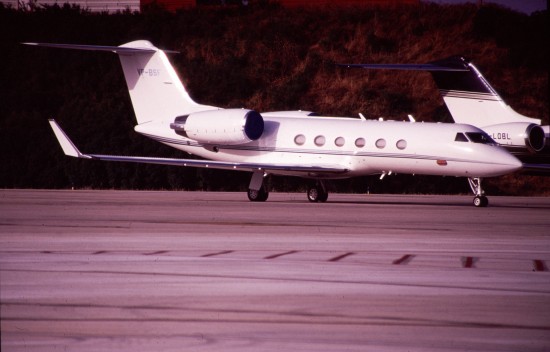
| Date: | Wednesday 1 December 2004 |
| Time: | 16:23 |
| Type: |  Gulfstream G-IV |
| Owner/operator: | GAMA Aviation |
| Registration: | G-GMAC |
| MSN: | 1058 |
| Year of manufacture: | 1988 |
| Total airframe hrs: | 7452 hours |
| Engine model: | Rolls-Royce Tay 611-8 |
| Fatalities: | Fatalities: 0 / Occupants: 9 |
| Aircraft damage: | Substantial, written off |
| Category: | Accident |
| Location: | Teterboro Airport, NJ (TEB) -
 United States of America United States of America
|
| Phase: | Landing |
| Nature: | Executive |
| Departure airport: | London-Luton Airport (LTN/EGGW) |
| Teterboro Airport, NJ (TEB/KTEB) | |
| Investigating agency: | NTSB |
| Confidence Rating: |
Gulfstream IV G-GMAC originally departed Farnborough Airport (FAB), and flew uneventfully to Luton (LTN). At Luton the passenger boarded for the transatlantic flight to Teterboro (TEB). It arrived in the Teterboro area and was cleared for an ILS runway 19 approach, sidestep to land on runway 24. Although the airplane encountered a gusty right crosswind, the approach was less turbulent than the flightcrew expected. The airplane initially overshot the extended runway 24 centerline, but the airplane was stabilized at 1,000 feet agl. The auto throttle and autopilot were disengaged during the approach, about 800 feet agl. However, the auto throttle reengaged just prior to touchdown, about 35 feet agl. The airplane touched down within the first 2,000 feet of the runway, and slightly right of runway centerline. The crew were not aware that the auto throttle had reengaged. The target airspeed set for the auto throttle
system was 138 knots. After touchdown, as the airplane decelerated below 138 knots, the auto throttle system gradually increased the power levers in an attempt to maintain the target airspeed. Without the power levers in the idle position, the ground spoilers and thrust reversers would not deploy. While the flightcrew was pulling up on the thrust reverser levers, they may not have initially provided enough aft force on the power levers (15 to 32 lb) to override and disconnect the auto throttle system. The flight data recorder indicated that the autothrottle system disengaged 16 seconds after the weight-on-wheels switches were activated in ground mode. As the airplane neared the end of the runway, the pilot engaged the emergency brake, and the airplane departed the right side of the runway. The airplane then traveled over a grassy area, struck trees, and came to rest upright.
PROBABLE CAUSE: "The flightcrew's inadvertent engagement of the autothrottle system, and their failure to recognize the engagement during landing, which resulted in a runway excursion. Factors were the lack of autothrottle switch guards, lack of an autothrottle engagement audible tone, and gusty winds."
METAR:
20:51 UTC / 15:51 local time:
KTEB 012051Z 27014G27KT 10SM BKN055 12/01 A2957 RMK AO2 PK WND 28034/2014 SLP014 T01170011 53039=
21:51 UTC / 16:51 local time:
KTEB 012151Z 29016G25KT 10SM FEW060 11/01 A2962 RMK AO2 PK WND 30032/2132 SLP031 T01110011=
Accident investigation:
 |
|
Sources:
FAA
NTSB
Location
Images:

photo (c) Pedro de la Cruz, via Werner Fischdick; Palma de Mallorca Airport (PMI); July 2002
Revision history:
| Date/time | Contributor | Updates |
|---|
The Aviation Safety Network is an exclusive service provided by:


 ©2024 Flight Safety Foundation
©2024 Flight Safety Foundation